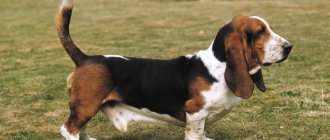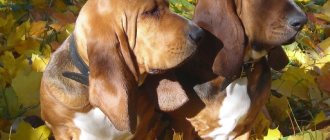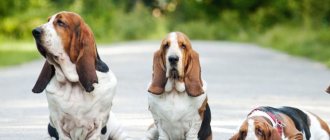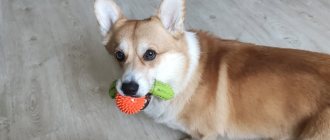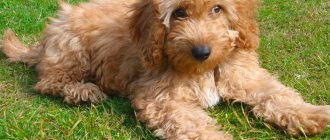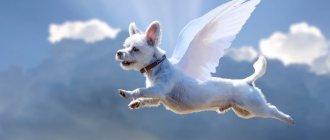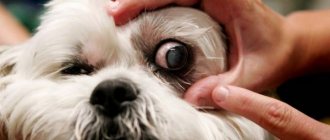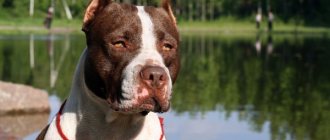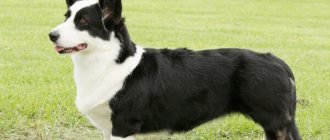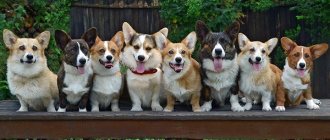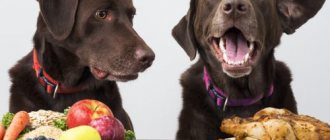What breeds are similar to the dachshund?
There are many breeds in the world whose representatives may look similar to a dachshund.
First of all, these are hounds, such as the Austrian smooth-haired Brack, which looks like a large black and tan dachshund with fairly long legs.
Here are some other dog breeds that are most similar in build to dachshunds:
- Australian Terrier;
- Artesian-Norman Basset;
- basset hound;
- Pembroke Welsh Corgi;
- blue Gascony Basset;
- Dandie Dinmont Terrier;
- drever;
- Sealyham Terrier;
- Skye Terrier;
- Scotch Terrier.
All of them are distinguished by a highly stretched body structure.
There are also a number of breeds similar to dachshunds in head shape, but long-legged:
- Austrian hound;
- Austrian big-breasted brakk;
- Alpine dachshund hound;
- Bavarian mountain hound;
- Schiller hound;
- Polish hound;
- Polish ogar;
- Slovakian hound.
There are also breeds similar to dachshunds, but with larger ears. In addition to Basset Hounds, these include much taller Bloodhounds or Swiss Hounds.
IMPORTANT! There are no long-legged dachshunds, since the breed standard states that the legs of these dogs should be shortened.
Description of the breed
Basset Hounds look strong, muscular and balanced. Smooth movements (specified separately in the breed standard) are achieved due to powerful paws and a wide, flat and long back. The dog's chest is slightly convex and is located between the forelimbs. The withers and croup are located approximately at the same height.
When assessing a breed, the following parameters are taken into account:
- The head is dome-shaped, tapering towards the muzzle. There are wrinkled folds on the forehead and brow ridges.
- There are hanging jowls above the lower lips.
- The teeth are strong, scissor bite.
- The nose is large, slightly protruding forward with a black nose (in individuals of light colors, shades of brown are acceptable).
- The neck is muscular, set high, but not long, with pronounced withers.
- The ears are long, hang down to the edge of the muzzle, and are rolled into a tube along their entire length. Delicate and velvety to the touch.
- The eyes are round with a clearly visible connective membrane. Acceptable colors are from light to dark brown; any other shade is considered defective.
- The tail is quite long and set high, when moving it rises up and bends slightly. It should not be straight or curled into a ring.
- The claws are strong.
- The paws are powerful with plump and round pads. The dog stands straight, weight is evenly distributed on four limbs.
The Basset's coat is hard, smooth and dense with folds in the skin. Long-haired dogs are not up to standard.
Colors
Based on color, Basset Hounds are divided into two large groups: two- and three-color. The latter belong to the classic color variant of these dogs; their body is covered with brown, white and black spots.
The following two-color colors are also acceptable:
- with white spots on a red background;
- with red spots on a white background;
- red dogs with white or lemon limbs (rare).
Gray coat color, which is presented by many sellers as rare, in most cases indicates a genetic abnormality. Albinos can also be susceptible to various developmental pathologies.
Size and weight
The Basset Hound is a fairly large dog, its height at the withers is from 33 to 38 cm.
Adult dog weight:
- from 23 to 29 kg for males;
- from 20 to 27 kg in females.
About 6 years ago, when the fashion for miniature breeds began, some unscrupulous breeders, having discovered defective puppies in a litter of standard-sized dogs, began passing them off as mini basset hounds. Such puppies are sold, as a rule, without breeding rights and at an inflated price. Such conditions and prices are explained by the exclusivity of the breed. In fact, this is a marriage. But in most cases it does not affect the dog’s life expectancy or character.
Basset Hound
Description
A good-natured and affectionate dog of low stature with a deep chest and a strongly elongated heavy body. The coat is short and thick.
A characteristic feature of Bassets is their very long, low-set, drooping ears, as well as a friendly look in their eyes, which gives these dogs a somewhat melancholy expression.
The most typical colors are tri-color and reddish-white, but any hound color is acceptable.
Basset Hounds measure from 28 to 38 cm and weigh 20-34 kg.
Character
Basset Hounds are affectionate, good-natured and non-aggressive dogs that, with proper socialization, get along well in the home with other animals. They are very good with children and love to play.
NOTE! Basset hounds are sensitive and vigilant, and their voice, due to its special timbre, sounds quite menacing, making them good watchdogs.
Peculiarities
With proper training, Basset Hounds become obedient and well-mannered dogs.
However, the hunting instinct and independent, and sometimes stubborn disposition often lead to the fact that the basset, left to its own devices, goes to investigate some trail and can get lost because of this.
Health and life expectancy
The Basset Hound is generally a very healthy breed and genetic pathologies are rare. The main danger for these dogs lies in their physique. A long spine with short limbs entails a risk of diseases of the musculoskeletal system.
The most common of them:
- dysplasia of the hip and elbow joints;
- curvature of the radius bones;
- pathological development of the cervical spine;
- panostitis;
- formation of cysts between the fingers.
The onset of back problems can be recognized by the following symptoms:
- pet's refusal to walk up steps;
- tremor;
- lameness;
- refusal to eat;
- paralysis of the back of the body.
Other possible diseases common to Basset Hounds include:
- glaucoma;
- dermatitis;
- enteritis;
- von Willebrand disease (blood clotting disorder);
- ectropia;
- volvulus;
- decreased thyroid function (hypothyroidism) is typical for mature dogs.
Most of these pathologies can be quite successfully cured or stopped if you consult a doctor in time. With proper care, Bassets rarely get sick; their life expectancy is 12-15 years.
Spaniels
A group of hunting dog breeds, descended from medieval Spanish dogs, whose purpose was to hunt game birds from dense thickets. Currently, spaniels are divided into those who hunt on land and the so-called “water ones”.
All spaniels share common characteristics of the breed - long ears and, as a rule, soft and silky, straight, wavy or even curly hair.
Most spaniels are short in stature. Only the Irish Water Spaniel, which measures 51-59 cm, can be considered a large breed.
Among modern spaniels there are also such exotic breeds as the Tibetan spaniel and Japanese chin. Despite their name, they are not related to real spaniels and are considered to be decorative dogs.
The colors of spaniels can be very diverse, both single-color and bicolor or tricolor.
Spaniels are characterized by poise, affection, activity, friendliness, intelligence and intelligence. They make not only excellent hunting dogs, but also wonderful companions - favorites of the whole family.
IMPORTANT! If a spaniel is raised incorrectly, then destructive traits such as aggressiveness, stubbornness and disobedience to the owner may appear in its character.
Spaniels are used as gun dogs. They can hunt waterfowl, field birds, as well as swamp and pine forest game. At the same time, they search for prey either by upper sense or by following the scent, but they do not make a stance on the bird.
Skin folds
Like many dogs of this type, the Basset's skin has numerous folds throughout the body and even along the head of this dog breed, including the forehead and area around the eyes, although they are not the most wrinkly dog breed. This gives them the characteristic of expressing sadness, although they are usually quite cheerful animals.
This does not occur in hounds, and the lack of wrinkles helps distinguish them not only from gundogs, but from most gundogs, such as the Spanish Hound or the San Huberto Hound, to mention two examples...
Pembroke Welsh Corgi
The Welsh Corgi, despite its small height, not exceeding 30 cm, is a shepherd dog.
Bred in Wales in the early Middle Ages, these dogs were widespread throughout Britain as early as the 10th century AD. Their main purpose was to herd livestock.
According to one legend, Pembroke Welsh Corgis were given to people by fairies, who used them instead of draft animals.
Pembrokes have short straight legs, a highly elongated body, large erect ears and a fox-like muzzle. A characteristic feature of these dogs is the black edging of their lips, which gives the impression that the dog is smiling.
The coat is shiny and silky, reaching approximately the same length as a German Shepherd, the undercoat is short and water-resistant. The color can be red and white, tricolor or fawn, sometimes black. The tail is usually short by nature or docked.
Pembrokes are friendly, active and affectionate dogs. They are good with other animals and children and love to play.
Pembroke dogs are very smart dogs, occupying second place in the ranking of the smartest breeds in terms of intelligence.
Usually, they do not speak often, but when greeting the owner who has returned home, some Welsh Corgis perform a kind of “song”, which is a characteristic howl with modulations.
Color
Their color is a major cause of confusion among these dogs, as most dogs of both races are tri-colored , meaning they have white, brown, and black tones in their fur, although many more colors are allowed in both cases.
In fact, they can be gray, white and black or white basset hounds with reddish tones, and in the case of hounds, a wide variety of colors are allowed...
In any case, it is quite common to find two-color Basset Hounds , white and brown, although it is not as easy to see Beagles, which do not have the breed's typical tricolor.
Beagle
The Beagle is a short dog with a compact, moderately muscular build. Its head and muzzle have a characteristic shape for hounds. The size of a beagle does not exceed 40 cm.
The ears are quite large, but shorter than those of the Basset Hound. The beagle's legs are usually long, and the tail, as a rule, is raised high, but not curled into a ring.
The coat is short, dense and waterproof. Of the colors, the most typical is tricolor (black, red and white), but any colors typical of hounds are acceptable, with the exception of liver.
Beagles are not known to be aggressive towards people or other animals. With proper upbringing and socialization, problems with their behavior, as a rule, do not arise.
These dogs, who treat all their owners equally well and simply adore children, make wonderful pets and companions. But, at the same time, it is also a magnificent, albeit small, hunting dog, which is used to drive a wide variety of game.
A highly developed hunting instinct can force even a well-trained beagle to go investigate some trail that interests him. That is why they need to be kept either indoors or in a well-fenced area.
NOTE! When walking, beagles should not be let off leash in open spaces.
Puppies
A newborn beagle weighs 250-450 g. The puppies are still absolutely helpless. But in the first month they are completely transformed - they stand on their feet, open their eyes, and show genuine interest in the world around them.
During the period of active growth, dogs especially need balanced food. The little beagle, which is not yet a month old, feeds exclusively on its mother's milk. Then they begin to introduce complementary foods. At this time, food is given 6 times a day at regular intervals.
Gradually new products are introduced into the diet:
From six months to a year, the animal is fed 3 times a day, the diet is as close as possible to that of an adult. The puppy should look moderately well-fed, but not fat. An adult beagle eats 2 times a day. Using the table below, you can track the correct development of your beagle dog by month.
AgeHeightWeight
| 1 month | 18-20 cm | 1.5-2 kg |
| 2 months | 22-25 cm | 3-4 kg |
| 3 months | 28-30 cm | 5-6 kg |
| 4 months | 30-32 cm | 7-8 kg |
| 5 months | 32-34 cm | 8-10 kg |
| 6 months | 33-35 cm | 9-11 kg |
| 7 months | 35-37 cm | 11-13 kg |
| 8 months | 36-37.3 cm | 12-14 kg |
| 9 months | 36.4-37.5 cm | 13-15 kg |
| 10 months | 37-38 cm | 14-16 kg |
| 11 months | 38-39 cm | 15-17 kg |
| 12 months | 38-40 cm | 16-18 kg |
Growing up passes very quickly - within a year the beagle grows to the size of an adult dog.
Drever
The Short-legged Hound of Swedish origin, also called the Swedish Dachshund Bracket, was developed in the early 19th century when hunting with regular, long-legged hounds was prohibited.
With its elongated body and short limbs, the drever resembles a dachshund, but it is more massive and muscular. Its height is from 30 to 36 cm. The head is somewhat large compared to the body. The ears are hanging, not too large, low set. The tail is quite thick at the base, never rising above the line of the back.
The coat is short, close-lying, harsh and straight. Any colors are allowed except pure white and liver, but the tree must have white markings that are clearly visible when viewed from any side.
A brave and tireless hound, at home she is affectionate and cheerful. The tree can make a very good companion.
Drevers are used to hunt foxes, hares, and sometimes larger game. At the same time, dogs of this breed can work both alone and in a pack.
Nowadays, drevers are increasingly becoming just pets.
Breeding
The Basset Hound is artificially bred, and therefore, despite the fact that these dogs (if they are healthy and not overfed), in general, tolerate pregnancy and childbirth normally, some difficulties may arise when breeding them .
Firstly, there are few dogs of this breed, especially high-quality ones, and therefore
difficulties arise already at the stage of selecting a pair .
Secondly, due to the raw type of build and short stature of dogs of this breed, as a rule, they have to be bred by hand .
Thirdly, Basset Hounds are not one of the easiest breeds to raise, and they usually have a lot of puppies in a litter .
If we talk about breeding, then it should be mentioned that females of this breed breed for the first time after six months. They should be mated only on the third heat, and mating is usually prescribed 10–11 days after its onset. Pregnancy lasts about two months, after which the dog gives birth to from 4 to 10 puppies , the birth, as a rule, is uncomplicated and most often does not require any intervention from the owner.
IMPORTANT! Due to the fact that basset dogs have an incredible appetite and at the same time have a tendency to obesity, it is necessary to allow only dogs with a normal build to be mated, and during pregnancy, carefully monitor that the dog does not become fat, as this will certainly lead to complications during pregnancy. the second half of pregnancy and during childbirth.
History and origin
The Basset Hound was first mentioned in a text about badger hunting dating back to the 16th century. People have used short-legged dogs since ancient times, but it is unknown when exactly this breed was successfully developed.
Dog breeders in pre-revolutionary France bred short-legged breeds for hunting. After the French Revolution, hunters began to breed hunting dogs that could be followed on foot. This breed had to be strong, heavy-boned, short-legged and have a good sense of smell.
The Basset was an excellent choice because it moved slowly, allowing the hunter to easily attack game. Although the dog was typically used to hunt rabbits and hares, it could also hunt large mammals. As a result, 4 types of short-legged hounds were bred, of which the Artesian-Normandy Basset was most similar to the modern Basset.
At the end of the 19th century, the dog was crossed with a bloodhound to increase its size. The resulting result was then crossed with an Artesian-Normandy Basset. At the same time, the breed appeared in America and England, which led to an increase in its popularity. In the mid-20th century, the Basset Hound became popular as a pet. Thanks to its funny appearance, the dog has also become famous in the entertainment industry and the world of advertising.
Currently, the basset's soft, non-conflict nature ensures the affection of dog lovers, hunters and families.
Care and maintenance
Beagles are working dogs, so they are very unpretentious. Care consists of timely hygiene procedures, proper feeding and education.
The right diet
Hounds can be fed both natural food and industrial feed. Many dog breeders choose the second option because it saves time, eliminates the need to carefully select products and introduce vitamin complexes into the diet.
Animals are bought high-quality super-premium or holistic products intended for active breeds. With natural nutrition, the menu includes:
- lean meats and offal (70%);
- porridge (25%);
- vegetables (5%).
Periodically, dogs are given sea fish, dairy products, eggs and fresh herbs. Fruits play the role of treats.
Walking and physical activity
The Beagle is a hound breed, so it cannot live without movement. The dog needs to regularly throw out the accumulated energy, otherwise it will upset the whole house. On the street, the pet should frolic to its heart's content - it is advisable to let it off the leash. It is better to do it in places where there are no cars or other animals.
Your pet will be happy to go into nature - to the forest or to the river bank. Here he will find many new smells and sounds, as well as the pursuit of birds and small animals. The dog should not be let out of sight: having felt freedom, it stops obeying, which is why it can get lost.
On a note. Dogs are walked 2-3 times a day for at least 40 minutes.
Training and education
Hounds have a freedom-loving and willful character, so they need to be trained from a very early age. It is advisable that the owner has experience training hunting dogs. Unlike service breeds, they will not obey commands unquestioningly.
The pet is inclined to make decisions independently. First he will think whether the owner’s demand is so important. If the dog considers the order useless, he will quickly put on a mask of complete misunderstanding and stop hearing and seeing everything that is happening around him.
The main task is to show the animal that man remains the undisputed leader. To do this, you need to act firmly and patiently. The best motivator is sincere praise and tasty treats. If you use violence and shout, the dog will withdraw into itself and try to do something nasty in response.
If problems arise with training, it is recommended to contact a professional dog trainer. Like all city dogs, it is advisable to undergo OKD to develop basic skills. Don’t forget about timely socialization. Once the Beagle puppy has become comfortable, he is carefully introduced to other people and canines, new sounds and smells. This way he will learn to adequately interact with the world around him.
Important. Due to lack of socialization, dogs grow up nervous, aggressive and hysterical.
Hygiene
Short hair is brushed a couple of times a week with a brush or rubber mitt. During seasonal molting, the procedure is carried out more often, using a special device - a furminator.
Bathing is required only if the pet is very dirty. Beagle dogs are washed with hypoallergenic shampoos designed for short-haired animals. Then the pets are thoroughly dried with a towel and left to dry away from drafts.
On a note. After a walk, just wash your paws and wipe your tummy with a damp cloth.
The eyes are inspected daily for the presence of dust and secretions, and if necessary, wiped with cotton wool soaked in an antibacterial solution. Ears are cleaned once every 2 weeks. Claws are shortened as they grow, unless the pet grinds them down on his own. Oral health is maintained with a brush and veterinary paste or dental treats.
Vaccinations and susceptibility to disease
Puppies are vaccinated for the first time at 8-12 weeks. After 21 days, a revaccination may be required - it all depends on the vaccine used. The main dangers are the following diseases:
- plague of carnivores (distemper);
- rabies;
- parainfluenza;
- parvo and coronavirus enteritis;
- hepatitis;
- adenoviral infection;
- leptospirosis.
The veterinarian can adjust the schedule, taking into account the pet’s living conditions and the prevalence of diseases in a certain area. Adult dogs are revaccinated annually and treated against fleas, ticks and worms every 3 months.
The Beagle dog breed boasts good health, but due to its structure, it often has problems with the eyes and ears. She is also susceptible to:
- hip dysplasia;
- epilepsy;
- achondroplasia (bone growth disorder);
- hypothyroidism (decreased thyroid function).
Regular hygiene and annual visits to the veterinarian will help protect your pet from disease.
Can a beagle live outside?
A one-room apartment is not the best place to keep an active hound. A private house with a large fenced area is more suitable for Beagles. here he will be able to run, jump and give free rein to his hunting instinct.
In the southern regions, a pet can live on the street all year round, provided that it has a warm kennel. Dense fur protects well from bad weather, but the animal is not able to withstand severe frosts.
The main danger facing a Beagle dog in winter is hypothermia. A pet with a cold instantly weakens its immunity. There is a high chance that he will get sick:
- cold;
- pneumonia;
- arthritis;
- otitis media
Prolonged exposure to cold is fraught with inflammation of skeletal muscles, kidneys and ureters. When walking in winter, your beagle should be dressed in overalls.
Important. Hounds must not be kept in a cage or on a chain. Such conditions are fraught with serious problems with both physical health and mental health.
Lifespan
Hounds live on average 12 years. But with proper care, good heredity and timely vaccinations, representatives of the Beagle dog breed can easily cross the 15-year mark.
Beagle - review
I’ll share my impressions about this breed, in case someone thinks about it and doesn’t make our mistake. I’m sitting now and thinking, why didn’t I read the reviews before buying? But here my inherent stubbornness came into play - I want everything. I wanted it) the time has come and we bought a 4.5 month old girl. By this time, she had already lived with the same family and was sold to us under the pretext of an urgent departure... Happy, we took the dog and went home. It should be noted that this is not my first dog. At various times I had the opportunity to live with a poodle, an Airedale, a dachshund, a hound mix, a spaniel, a bulldog and a boxer. Oh, if only I knew what awaited me with the beagle!!!
1. Why is it not written anywhere in the description of the breed about this unbearable dog smell? We brought her home at 10 pm, and by 6 am we were all literally throwing up from the smell of the dog. At the same time, she was bathed and healthy... My dogs looked like a Russian hound mix, but unfortunately I didn’t think about the fact that this is common to all hounds...
2. We have nowhere to let her off the leash; we walked on a leash in the evening for about 2 hours with short runs. In the morning at 5 am I already had the pillows torn from the sofa, my son’s toys had been gnawed, and a large ficus had been eaten. At the same time, the soil from the pot mixed with urine was all over the apartment, including on the sofa.
At the same time, she is a very beautiful, smart, affectionate girl. She is absolutely not to blame for either the smell or super activity. These are the characteristics of this breed!!! So far, neither we have become attached to her, nor she was given to us by a familiar hunter in the private sector the next day, where she is absolutely happy with other hunting brothers. And we will take a break and breathe out, after such an experience we will think hard the next time when choosing a breed.
Where to buy and price
A Basset Hound should be purchased from a nursery (Merconi, Pridebass, Iz Blueberry Paradise), where experienced breeders will explain how to properly raise and maintain this difficult breed. The price of a puppy varies from $100 to $700. Before purchasing, you must carefully check all the documents of the pet’s parents, including medical ones - basset hounds are healthy dogs and most of their diseases are hereditary. When buying a dog based on an ad on the Internet or from someone else, there is a risk of getting not only an individual that does not meet the breed parameters, but also a sick baby.
Similar breeds - comparison and differences
There are several dog breeds that closely resemble the beagle in appearance, but have their own distinctive characteristics. Of course, they can be crossed, but the puppies do not participate in exhibitions. The character of most of these pets is as cheerful as that of the beagle. Let's consider all mestizos and similar breeds separately.
Estonian hound
The Estonian Hound, like the Beagle, belongs to the same type of dog that is bred for a specific purpose - hunting. Therefore, they are considered hunting dogs, so when walking you should stay as far away from small animals as possible, but not if you are going on a real hunt.
The breeds are similar to each other because beagles are the ancestors of the Estonian hound. They need physical activity, they like to walk for a long time, stick their nose where their hunting instincts lead them. They do not like a sedentary, and even more so a sedentary lifestyle. We are happy to spend time in the company of our owner and do something interesting and entertaining.
Important! A sharp mind and independence are also integral character traits, so education must be taken seriously, honing each command so that the dog grows up obedient and does not cause trouble.
This breed of dog does not require special care; it is easy to maintain; you just need to comb its coat with a comb 1-2 times a week.
The Estonian hound, like the beagle, does not particularly pretend to be the leader in the family, demonstrating superiority over the owner.
The difference between the Estonian hound and the beagle
Despite the fact that both breeds have a similar color, drooping ears, and build, they are different in appearance. Estonian hounds are more elegant, slender, and taller than beagles, while the latter are more squat and stocky.
Reference. There are certain differences in character: the Estonian hound is characterized by obedience and is more amenable to training. This breed, compared to the beagle, can be called calmer, more reserved and obedient, because it will unquestioningly carry out your command. She will not dig up the fence, thereby causing inconvenience to the owner. Doesn’t need such attention and tolerates loneliness more easily, which can be beneficial for people with a working lifestyle. Compared to the Beagle, the Estonian Hound will not run around begging for affection and games, but if you offer it all this, it will only be happy. Doesn't trust strangers.
As for the character of beagles, they are real fidgets - these dogs are ideal for people who don’t mind doing a couple of laps around the park in the morning.
Attention! They like to spend as much time as possible with people, and not only with their own people, as they treat strangers well. Hence the conclusion - the dog should be taken out for walks on a leash, otherwise it may go in search of adventure on its own curious nose and get a treat from someone else’s hands.
What cannot be said about the Estonian hound, she is suspicious of strangers; a timely command will put her in her place if she decides to sniff a foreign smell.
Beagles are stubborn and much more active, which means they can be difficult to train despite their natural intelligence. An ideal training option would be training in the form of a game. The working qualities of these breeds are also distinctive: beagles work in a pack, their goal is to drive the prey, while the task of the “Estonian” is slightly different.
The hunting of the “Estonians” looks more spectacular and serious, because the victims of these dogs are impressive in size - these are hares, deer and wild boars. The dog must not only drive the victim, but also drive him crazy, accompanying this fascinating process with a ringing bark so that the owner knows where his pet is.
Jack Russell Terrier
Important! Jack Russell Terriers, like Beagles, are hyperactive and love attention from everyone around them. They are like little children - they examine everything with curiosity, constantly strive to involve someone in the game, and dig holes. Both dogs need proper attention.
The process of training a Jack Russell Terrier brings as much trouble as training a Beagle. Both pets are quite stubborn, so it’s worth trying to make the pastime as exciting as possible.
Attention: Well, once again it is worth touching on the topic of the attitude of the Jack Russell Terrier and Beagle towards strangers. They are the life of the party, always friendly to strangers, so you need to be on your guard. Of course, both simply adore their household members and need to be dealt with. If this is not done, then they may have a nervous breakdown, a beagle - from spending a long time alone, a Jack Russell terrier - from lack of attention and a long-awaited walk.
They treat children very well. We can say with confidence about the beagle: without thinking twice, he will definitely fall in love with your child. Both dogs, especially the Jack Russell Terrier, will happily agree to have fun in this exciting game. The main thing is that the child is not less than 7 years old.
Difference between Jack Russell Terrier and Beagle
The Jack Russell is a specialist in burrow hunting, mainly foxes and small rodents. The Beagle is a master tracker; its excellent sense of smell allows it to track its prey. This is an indispensable hunter for slightly different game: hares, and sometimes wild boars.
Although both the Beagle and the Jack Russell love to be the center of attention, at home the Beagle is calmer and will happily curl up on the couch with you watching your favorite TV series.
Help: Although the Jack Russell Terrier is a small dog, it can compete with others in terms of leadership, but it will not miss the opportunity to show family members who is boss in the house. The Beagle makes no special claims to leadership. In the family circle, both do not show aggression, but on the street, a beagle can only pay attention to a cat, so this breed is quite friendly to other animals. The Jack Russell Terrier also does not stand out as particularly aggressive compared to the Beagle; it can condescend to other pets and respond with at least interest. But not on the street - here he will turn into a jealous dog who will bark at everyone and everything, such is the nature of this breed. While the Beagle would consider a hasty reaction in the form of displaying its voice, the Jack Russell would not. Attention! Due to its suspiciousness, the Jack Russell will serve you as an excellent guard dog, but it is better not to take it as a bodyguard. And the beagle is very friendly and hospitable, so it will not serve in one or the other.
Basenji
The Basenji is also energetic, extremely active and optimistic. Requires constant attention and does not tolerate loneliness. If you walk it for a long enough time, the house will be calm. He has a well-developed hunting instinct. Similar to the Beagle in the same kind and affectionate temperament: the Basenji will also love all family members, and will also get along with other dogs. He gets along with children and will be a good friend to them, but it is worth considering that a dog is not a toy, and she also understands this and will not allow herself to be treated like an inanimate object.
Attention! They are smart and easy to train, but very curious and nimble, so they can often disobey their owner, so they also need a firm hand during training. Being carried away by the chase, they can easily get lost; you can’t do without a leash on a walk.
Difference between Basenji and Beagle
Erect ears, not so strong build, not wide chest, tightly curled tail. On their long legs, Basenjis move with long strides and a straight, stately back.
Help: If the beagle is not the best choice of this breed as a watchdog, then the Basenji, when it detects a stranger on the territory, will let you know about it with its purring and tense posture, because they do not know how to bark. Yes, nature deprived them of this quality.
Basenjis are more in demand as companions; they live well in an apartment with an active lifestyle. But in Africa and other parts of the world they are still used for hunting. They become essentially attached to only one family member and treat strangers with indifference.
Important: They are odorless and hardly shed, so they do not require special care. And you shouldn’t wash them often, as they are afraid of water. Only if the dog is very dirty, wash it. If for others it is enough to feed good and proven food, then Basenjis are very demanding when it comes to food - they are exactly the type of breed whose diet needs to be given special attention. The basis of their diet should be lean raw meat. For all their mobility, which helps them maintain a healthy shape, Basenjis can suffer from kidney and digestive diseases, as well as hernias.
Dogs are suitable for living in a large family, they are not aggressive, and therefore can easily make friends with other pets. The same can be said about their relationship with children; a basset hound will serve as a good nanny for a child; he does not rush back and forth like crazy, so the likelihood of being knocked down is minimized.
Attention! As for training, it’s not very smooth here either. Bassets are skittish dogs, they value their importance highly and may refuse to follow your commands.
Loneliness can affect not only your moral health, but also your property and the nerves of your neighbors. The Basset Hound has a very clear voice and a loud bark.
Important! You should also not walk without a leash, given the hunting predilections of this breed, however, this applies to all hunting dogs. It is necessary to exercise them with long walks, although they are not as active as beagles. Otherwise, the dog will simply become obese, especially in a city apartment. By the way, this is where the conclusion is drawn about an individual approach to pet nutrition.
Difference between Basset Hound and Beagle
Basset Hounds are large, short hounds. They are rare stubborn people who love to piss off their owner, but, nevertheless, this does not prevent them from being affectionate and devoted companions. They have a sedentary lifestyle and behave well in public. These dogs hunt for small rodents such as rabbits and others.
Important! Due to the fact that they have short legs, they quickly get their fur and ears dirty. They have their disadvantages due to their long body - limitation of some full-fledged body movements.
Help: From an early age, the Basset Hound should show who is boss and show his leadership qualities, otherwise, without thinking twice, he will sit on his head.
Corgi
Friendly and sweet creatures. They reverently and equally love their owner and the entire family in which they live, without giving the appearance that they give special preference to this or that person. Corgi will always understand what they want from her. Has a very positive attitude towards children.
This is a cheerful and active dog, it will always be happy to play some exciting game with you, but it is not intrusive. Loves long walks outside.
The difference between a corgi and a beagle
Corgi is a herding dog. Belongs to the shepherd family. Its miniature size allows this dog to deftly dodge hooves and horns during herding work.
Gets along easily with all other pets, cats are no exception. Calmly tolerates life in an urban environment.
For an obedient and intelligent corgi, there is no difficulty in remembering a command the third time, or even the second time. All character flaws can be developed in a dog through training, which is a huge plus.
Attention! Corgis are prone to overeating. Carefully monitor your pet's weight and do not overfeed. If you notice that your pet is overweight or short of breath, take him to the veterinarian.
Dachshund
The dachshund is a hunting dog with a friendly nature, similar to the beagle. A non-aggressive, small, agile dog with good instincts.
The dachshund is an ideal hunter who specializes in badgers, foxes and raccoons. Will always warn of larger extra animals nearby.
The difference between a dachshund and a beagle
Brave, serious, purposeful and independent. She has protective qualities and a loud voice. All this makes it both an excellent hunting dog and an excellent guard dog.
Mating
Before mating, you need to remember that the appearance of offspring will require the owner to spend a lot of time caring for the dog and puppies. The Basset Hound's first heat occurs at about six months, but you need to wait until the dog's body is fully formed. For males, the ideal age for mating is 2 years, for females - 20 months (after the third heat).
Breeding basset dogs is not an easy procedure. The male needs to be selected in advance and the dogs introduced so that the female feels more relaxed. Breeders recommend holding the dogs during the process so that they do not cause pain to each other with sudden movements. After a couple of days, the procedure should be repeated, since there is no guarantee of pregnancy.
If the mating was successful, you should begin preparing for the birth and arrange in advance with a veterinarian who can come if something goes wrong. It is worth preparing a special place for whelping. A large box with sides works well. The bottom should be lined with newspapers and soft rags that will absorb the liquid. After birth, all this must be removed and replaced with dense, warm bedding.
You should not leave the bitch to give birth alone; first-born Bassets often do not handle the puppies on their own and do not chew the amniotic sac - in this case the owner will have to do this, otherwise the puppies will die. In addition, hounds are heavy and can crush babies. Bassets have very strong contractions; the first puppy should be born no later than 3 hours later. If this does not happen, you need to call a veterinarian. He will also examine the dog after birth.
Métis
Beagle plus pug
The cross between the pug and the beagle resulted in a separate breed called the puggle. He is very reminiscent of a large, short-legged, athletically built pug, with an elongated, wrinkled muzzle and drooping ears. The crossbreed is interesting because it is difficult to predict what the puppies will look like. She contains the best characteristics of both parents.
This is an active dog that is friendly to people and children. Very playful and curious.
Attention! A dog may develop a hunting instinct, or maybe not, depending on who it inherits more from. And yet it is clear that in any case the dog will be smart, loyal and resilient. Hybrids are more likely to have a healthier dog than its parents. But it is worth considering some nuances that may make themselves felt due to the fact that the puppy will inherit some pathologies, and also monitor the pet’s nutrition.
The puggle inherited hyperactivity from the beagle, so physical activity is required in the form of walks, but not too long.
Note: Easy to train, but can be somewhat stubborn.
Jack Russell mix
The Jack Russell Terrier was crossed with the Beagle to create the Jack Bee (Jack Bee). The breed is more popular abroad, so you don’t see it often here. This is a small, brave, assertive dog. It is most often used for hunting, as it has all the necessary qualities: agility and high running speed.
Help: Jack-bee is an excellent pet, loving and devoted to its owner. But it can plague you with its hyperactivity and cheerful disposition, which can be corrected by active walks.
Attention! Some problems may arise in parenting, this is due to the stubbornness and cunning of Jack-a-B. It is also worth being aware of the dark side of the dog's character, which can be aggressive and bite if teased. Doesn't always get along with other dogs.
Despite its miniature dimensions, it can become a good watchman.
Basset hound and beagle mix
The Beagle Basset Hound will charm you when you meet him and become a very good friend for life. The dog has a well-developed sense of smell, which it constantly uses, exploring everything. A noisy and playful individual is not suitable for living in a city apartment; it will be completely uncomfortable and cramped there.
Since the breed is a hound, the Basset Hound and Beagle mix is an excellent hunter. The dog is mischievous and loves to run, splashing out the accumulated energy during the night, and you need to take a lot of long walks with it. It will be a great friend for a child, playing and entertaining him non-stop.
The mixed breed needs control; the Beagle Basset Hound is a hunter by origin, and therefore he will not miss a single opportunity to hunt squirrels and other small game. Also, your pet will have no problem making friends with other pets in the house.
With a spaniel
An active dog that will be a good helper for those who love to hunt. Restless, friendly, non-aggressive. Perfect for families with children. It is believed that nothing can lure a beagle into the water, but a spaniel loves to swim - so the mixed breed will turn out to be a good swimmer. The main difference between the breeds is that the spaniel is easier to control.
Dachshund and Beagle mix
The unpredictable, stubborn nature that both breeds possess will also manifest itself in the mixed breed. In appearance, the dog will look organic, since it will be taller than the dachshund, slightly less elongated. This pet will not participate in exhibitions, but it will be ideal as an apartment dog.
Dad is a beagle, mom is a husky
In this combination, the puppies will have beagle-like muzzles, triangular hanging ears will be husky-like, and the coat will be thick and slightly longer than that of beagles. This pet will need long walks and a lot of attention. Keeping such a mestizo in an urban environment is not the best option. They live better in their own home, but only when they have freedom of action and participate in the hobbies of their owners (hunting, fishing).
Is it possible to breed an Estonian hound with a beagle?
It is difficult to understand whether the beagle in front of you is a purebred or a mixture with an Estonian hound if the puppy is less than 3 months old. Participation in exhibitions of a cross between these breeds is impossible, therefore, if you want a purebred puppy, ask the breeders for documents and photographs of the parents, find out the pedigree.
In conclusion, it is worth noting that all the dog breeds listed above have their pros and cons. Everyone decides for himself whether this or that habit is a minus or a plus.
Training and education
The Basset Hound is very difficult to train and prefers to decide for itself what to do and when. But by showing endurance and patience, you can achieve good results in raising a dog. While he is still small, he can be taught the rules of behavior in the house, but it is very difficult to achieve anything from an adult representative of this breed. Therefore, you need to train your baby as soon as he appears in the house. It is important to remember that Basset Hounds are social animals and need a clearly structured hierarchical structure. The owner must prove his dominance to the dog, otherwise the basset will become the leader himself and will do whatever he wants.
Basset hounds are excellent psychologists and understand perfectly well who is best to obey and who can give in if they just make a pitiful grimace (of which there are many in the arsenal of a funny baby). Immediately, as soon as the puppy has settled in the new apartment, you should teach him the place command and not allow him to climb into the owner’s bed, otherwise when the dog grows up, he will have to win his bed each time.
Another problem of this breed is that its representatives are big fans of trashing houses, they can even do this out of revenge for an insult. Toilet training a basset puppy is a labor-intensive process. The digestive system of such dogs is quite weak and they need to be taken outside 3 times a day. If the puppy pees at home, you need to scold him. For going to the toilet on the street, praise and encourage him every time. At first he will try to earn the praise of the owner, and then he will get used to following the rules.
From an early age, the dog must follow basic commands (to me, next to me, etc.). If you want the dog to give a paw, you need to act as follows: when pronouncing the command, take the paw in your hands and repeat several times. Afterwards, the pet will understand the requirement and will perform the necessary action itself. Execution of the command “take” is necessary so that the dog does not eat everything and whenever it wants. To achieve results, you need to hold the puppy by the collar while placing the bowl of food and let go only when the command is pronounced. Over time, he will wait for the command before starting to eat.
In the training process, consistency and rigor are important, but not cruelty. Force and beating will not achieve anything from a basset hound. For these dogs, encouragement or reprimand from their adored owner is of great importance.
